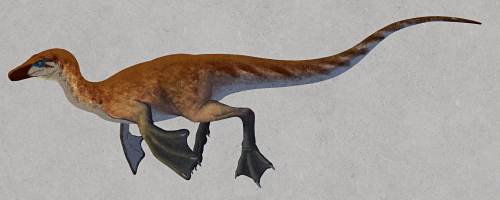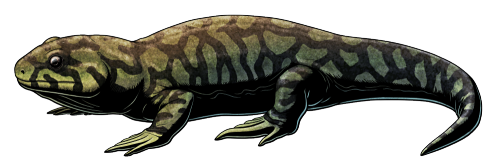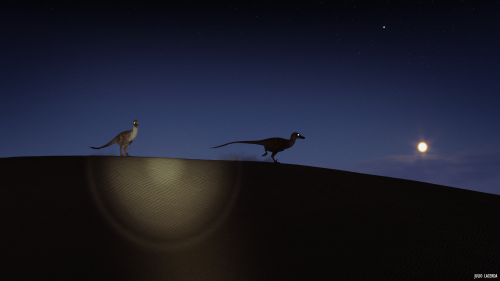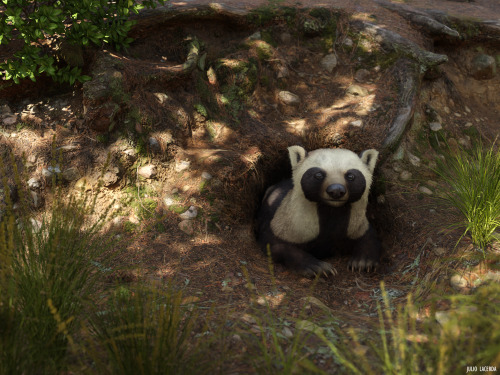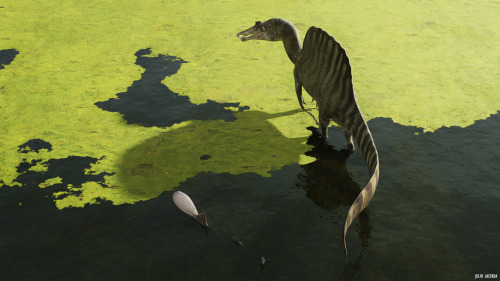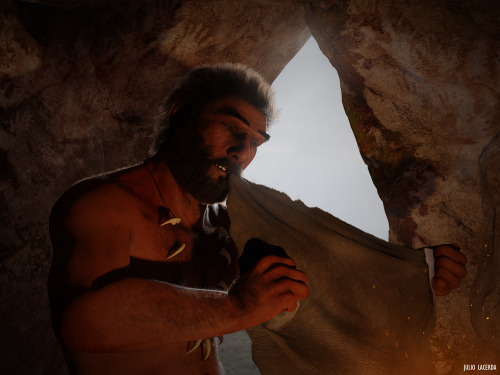#palaeoblr
Amargasaurus cazaui was a sauropod dinosaur with a very distinctive-looking skeleton, sporting a double row of long bony spines along its neck and back. It lived in what is now Argentina during the Early Cretaceous, about 129-122 million years ago, and was fairly small compared to many other sauropods, reaching about 10m in length (~33’) with a proportionally short neck compared to its body size.
And despite being known from fairly complete skeletal remains there’s still a lot we don’t know about this dinosaur – especially what was actually going on with those vertebral spines. While it’s sometimes been depicted with skin sails over the spines, for the last couple of decades the general opinion has trended towards them being more likely to have been covered by spiky keratinous horn-like sheaths.
But recently that’s been brought back into question. A detailed study of the microscopic bone structureofAmargasaurus’ spines shows no evidence for keratin attachment and instead found textures associated with skin coverings, along with an extensive web of ligaments connecting the spines to each other along each row.
So maybe it had big flashy sails after all!
———
Nix Illustration|Tumblr|Twitter Patreon
Post link
It’s been a while since I last showed off some of these, but here’s some more commission work I’ve done for PBS Eons:
- Themetriorhynchid marine crocodilians AggiosaurusandCricosaurus, from “When Crocs Thrived in the Seas”
https://www.youtube.com/watch?v=vgqs_9BBX10
And…what’s this?

A familiar Scutellosaurus makes an appearance in a recently-published children’s dinosaur book!
———
Nix Illustration|Tumblr|Twitter|Patreon
Post link
April Fools 2022: The Aquatic Dinosaur That Wasn’t
So,Spinosauruswasn’ttechnically the first known aquatic non-avian dinosaur.
That title instead temporarily went to Compsognathus corallestris.
While the idea that hadrosaursandsauropods were wallowing swamp-dwellers had been completely abandoned at the start of the Dinosaur Renaissance, the new view of dinosaurs as active sophisticated animals led to a surprising aquatic hypothesis during the early days of this paleontological revolution.
A specimen of the small theropod Compsognathus discovered in southeastern France in the early 1970s was only the second skeleton ever found of this dinosaur, and came over a century after the first. It was initially thought to represent a new species since it was about 50% larger than the German specimen of Compsognathus longipes, and it seemed to have something very unusual going on with its hands – its forelimbs were somewhat poorly-preserved and distorted, and had traces of some sort of large fleshy structure around the hands that was interpreted as representing elongated three-fingered flippers used for swimming.
This wasn’t necessarily as ridiculous of an idea as it might sound. Compsognathus lived during the Late Jurassic, about 150 million years ago, at a time when Europe was a group of islands in a shallow tropical sea. A semiaquatic dinosaur specialized to swim and dive, hunting the abundant aquatic prey in its environment, and easily able to island-hop all around the European archipelago seemed at least somewhat plausible, and reconstructions of fin-handed C. corallestris even appeared in several popular dinosaur books of the time.
But it didn’t last.
Within just a few years doubt was being cast on this idea, and further studies of both known Compsognathus skeletons in the late 1970s and early 1980s concluded that C. corallestris was actually a fully-grown adult individual of the juvenile C. longipes. The French Compsognathus had normal-looking hands for its kind after all, with two large clawed fingers and a vestigial third finger, and the “flipper” impressions had just been ripples in the fossil slab.
For a long time after that the general view became that there just weren’t any aquatic non-avian dinosaurs at all – but more recent discoveries like the new Spinosaurus material and Halszkaraptor are starting to suggest that some of these animals were much more at home in the water than previously thought.
Something resembling Compsognathus corallestris might still surprise us in the future.
———
Nix Illustration|Tumblr|Twitter|Patreon
Post link
Retro vs Modern#23:Spinosaurus aegyptiacus
Spinosaurid teeth were first found in the 1820s in England, but were misidentified as belonging to crocodilians. It wasn’t until nearly a century later that Spinosaurus aegyptiacus was discovered and recognized as a dinosaur – and it would be another century after that before we really started to learn anything about it.
1910s
The first fossils of Spinosauruswerediscovered in Egypt in the 1910s. With only a few fragments of its skeleton known it was an enigma right from the start, hinting at a large and very strange theropod dinosaur with crocodile-like teeth, an oddly-shaped lower jaw, and elongated neural spines on its vertebrae that seemed to be part of a huge sail.
A few possible extra fragments were found in the 1930s, but overall these few pieces were all that was known of Spinosaurus for a long time.
The fossils were kept in the Paleontological MuseuminMunich, Germany,a building that was severely damaged during a bombing raid in World War II. Many important specimens were destroyed, including Spinosaurus, and only the published drawings and descriptions of the bones remained.
So for the next several decades Spinosaurus remained a very poorly-understood mystery. During this period it was generally depicted as a generic “carnosaur”, often modeled on something like Megalosaurus, in the standard-for-the-time tripod pose and with a Dimetrodon-like sail on its back.
Interestinglya 1930s skeletal reconstructionshowsSpinosaurus with an unusually long torso and fairly short legs, details that are surprisingly modern despite the retro posture.
1990s
In the 1980s some partial snout bones from Niger were recognized as having similarities with the jaw of Spinosaurus. Around the same time the fairly complete skeleton of Baryonyx was discovered, and along with further spinosaurid discoveries in the mid-to-late 1990s a decent idea of what Spinosaurus might have looked like began to emerge.
It was reconstructed with a long kinked crocodilian-like snout, a ridged bony crest in front of its eyes, an S-curved neck, and large thumb claws on its hands – an interpretation that was heavily popularized by Jurassic Park III in the early 2000s, bringing this enigmatic dinosaur to public attention and portraying it as a fearsome super-predator bigger than Tyrannosaurus.
2020s
Despite attempts to locate more complete Spinosaurus remains, only fragments continued to be found, and it remained a frustratingly poorly-known species even into the early 2010s.
Finally, in 2014, almost a full century after it was first described and named, Spinosaurus started to reveal its secrets with the announcement of the discovery of the most complete skeleton so far, discovered in the Kem Kem fossil bedsinMorocco. Its body was still only partially represented, but it included skull fragments, part of a hand, a complete leg and pelvis, some sail spines, and several vertebrae from the neck, back, and tail.
And nobody was expecting what these pieces revealed.
It had a very long torso and proportionally short stumpy legs, and was reconstructed with a huge distinctive “M-shaped” sail on its back. Its feet had flat-bottomed claws and its “dewclaw” toe was enlarged into an extra weight-bearing digit – adaptations for spreading its weight over soft muddy ground, and suggesting its feet may also have been webbed. Initially it was also presented as possibly being quadrupedal, due to how far forward its center of mass seemed to be, reviving an odd idea from the late 20thcentury.
Along with its long crocodile-like head and conical teeth, this was interpreted as evidence it was a semiaquatic fish-eating swimming animal – potentially making it the first known semiaquatic non-avian dinosaur. Spinosaurids had been suggested to be specialized piscivores before, especially since Baryonyx had been found with fish scales in its stomach, but they were generally assumed to be more like modern grizzly bears, wading into water to hunt but not being habitual swimmers. Spinosaurus’ weird croco-duck proportions, however, seemed like they might be much more suited to watery habitats than to the land.
SinceSpinosaurus had become a popular dinosaur with the general public by that point, the discovery was big news – and a big controversy for a while. It was so bizarre that some paleontologists were skeptical of the radical new interpretation, wondering if the measurements of the skeleton were correct or if the short legs were even from the same individual or the same species as the rest of the bones.
After a while the new proportions were accepted as fairly accurate, and over the next few years attention turned to instead figuring out just how this animal worked and how aquatic it actually was. An earlier isotope analysis of its teeth supported a semiaquatic lifestyle similar to crocodiles and turtles, but a buoyancy study argued that it might not have been able to dive below the water suface and its sail made floating unstable – but also found that its center of mass was closer to its hips than previously calculated, suggesting it could walk bipedally after all.
Then in 2020 came another surprise: more of the tail of the new specimen had been found, and it was just as weird as the rest of Spinosaurus. Its tail was a huge vertically flattened paddle-like fin supported by long thin neural spines and chevrons, resembling a giant eel or newt more than a dinosaur and also giving some more weight to the idea that it was a swimmer.
Our modern view of Spinosaurus is still evolving, and likely to be full of even more surprises in the future as we discover more about this unique dinosaur. But we at least know it lived in what is now North Africa during the Late Cretaceous, about 99-93 million years ago, and whether it was a swimmer or wading generalist predator it was one of the largest known theropods to ever live, estimated to have reached around 16m long (~52ft).
While the “M-shaped” sail reconstruction has been popularized by the recent discoveries, the exact shape of this structure is still unknown. Like with other sailbacked animals it’s also not clear what it was for, with ideas including temperature regulation, visual display, supporting a fatty hump, and a potential hydrodynamic adaptation.
EDIT: And while I was working on this entry (late March 2022) I missed that another study had just come out with more anatomical support for swimming Spinosaurus!
———
Nix Illustration|Tumblr|Twitter|Patreon
Post link
Modern birds’ upper beaks are made up mostly from skull bones called the premaxilla, but the snouts of their earlier non-avian dinosaur ancestors were instead formed by large maxilla bones.
AndFalcatakely forsterae here had a very unusual combination of these features.
Living in Madagascar during the Late Cretaceous, about 70-66 million years ago, it was around 40cm long (1'4") and was part of a diverse lineage of Mesozoic birds known as enantiornitheans. These birds had claws on their wings and usually had toothy snouts instead of beaks, and many species also had ribbon-like display feathers on their tails instead of lift-generating fans.
Falcatakely had a long tall snout very similar in shape to a modern toucan, unlike any other known Mesozoic bird, with the surface texture of the bones indicating it was also covered by a keratinous beak. But despite this very “modern” face shape the bone arrangement was still much more similar to other enantiornitheans – there was a huge toothless maxilla making up the majority of the beak, with a small tooth-bearing premaxilla at the tip.
This suggests that there was more than one potential way for early birds to evolve modern-style beaks, and there may have been much more diversity in these animals’ facial structures than previously thought.
———
Nix Illustration|Tumblr|Twitter|Patreon
Post link
During the Early Carboniferous, around 330 million years ago, the region that is now the East Kirkton QuarryinScotland was located close to the equator, with a lush tropical climate and volcanic hot springs dotting the landscape. It preserves fossils of some of the earliest known fully terrestrial tetrapods, and a recent discovery shows how some of these animals were already experimenting with the shapes of their feet to better get around on land.
Termonerpeton makrydactylus is only known from a partial skeleton, and shows a mix of anatomical features that make identifying its exact evolutionary relationships rather difficult – but it was probably a very early reptilomorph, closer related to amniotes than to lissamphibians. It may also have been very closely related to the equally enigmatic EldeceeonandSilvanerpeton from the same region, but was almsot twice their size with a estimated total length of around 70cm (2'4").
It would have resembled a rather heavily-built lizard-like or salamander-like animal, with fairly stumpy legs and probably lacking claws on its digits. While it would have had spindle-shaped scales on its underside, and possibly small rounded scales along its sides and back, these were bony structures embedded in its skin and probably weren’t very visible externally in life.
ButTermonerpeton’s most surprising feature was its proportionally large feet with especially elongated fourth toes, which would have helped to extend its stride length for energy-efficient terrestrial locomotion and to stabilize its movement on unstable surfaces – a much more “advanced” amniote-like arrangement than expected in such an early reptilomorph, and convergently similar to to the foot shapes of some modern lizards. Its fourth toe was also unusually chunky, suggesting it may even have been bearing most of its weight on just that one digit when walking.
———
Nix Illustration|Tumblr|Twitter|Patreon
Post link
Night Stalkers
Yet another remake/reimagining of a 2012 illustration, featuring Velociraptors.
Patreon•Ko-fi•Facebook •Twitter•Prints & Merch
Post link
Two Neanderthal brothers surround a bull Megaloceros with spears 100,000-50,000 years ago near Germany’s Unicorn Cave. Artifacts attributed to Neanderthals, including a carved knuckle bone from the giant deer, have been found in the cave and suggest our cousins were also capable of producing artwork.
Patreon•Ko-fi•Facebook •Twitter•Prints & Merch
Post link
POV: You’re a female Ubirajara and you’re not impressed.
The discovery of this little guy has a very sad backstory that is unfortunately all too common in paleontology: it was smuggled out of its home country (Brazil), and there’s an ongoing campaign to repatriate it.
Patreon•Ko-fi•Facebook •Twitter•Prints & Merch
Post link
A Boreostemma takes a nap below a small Samanea during a hot afternoon in Urumaco, Venezuela. Alongside it, a small group of Bounodus eat the fallen fruit of the tree, while a Tinamou is taking a break on top of the glyptodont.
Check out Cenozoic Central’s Twitter thread about this scene to learn more about those species!
Patreon•Ko-fi•Facebook •Twitter•Prints & Merch
Post link
Another quick remake of an older piece; A female Spinosaurus wades through her native waterways while a boldOnchopristis swims nearby. Original from 2013.
Patreon•Ko-fi•Facebook •Twitter•Prints & Merch
Post link
One of the many things that distinguish us from other primates, and all animals for that matter, is a very marked preference for the use of one hand/limb over the other. While some other species show signs of individual preference, around 95% of humans are right-handed.
But handedness goes beyond simply preferring one hand over another, and there is a very interesting story behind how we developed that trait. Check out PBS Eons’ episode on the subject to find out more.
Shown here is a right-handed Neanderthal craftsman using stone tools to butcher a carcass and clean the animal’s skin.
Patreon•Ko-fi•Facebook •Twitter•Prints & Merch
Post link





